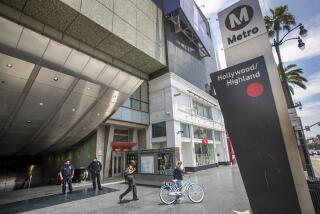2 O.C. Brothers Killed as Train Strikes Truck
FULLERTON — Two La Habra brothers were killed Monday when their pickup truck was hit broadside by a train as they drove around a railroad crossing gate, authorities said.
Police and witnesses said that at the time of the 3:15 p.m. accident, the crossing gates were closed over the intersection, warning lights were flashing and bells were ringing as Amtrak’s Desert Wind, bound for Los Angeles, approached from the east.
But the driver of the pickup moved into the railroad crossing anyway, officials said.
“He was trying to go around the arm to beat the train,” said Cindy Brooks, 32, who was waiting with her 8-year-old daughter at the crossing.
“I told my daughter, ‘Look honey, there’s a train coming,’ ” Brooks said. “We like to count the cars together. We looked back up right as the train hit” the truck.
The driver of the pickup, Jose Gutierrez, 29, and his brother J. Rosario Mejia Gutierrez, 20, were pronounced dead at the scene.
Authorities estimated that the Amtrak train, which had left Chicago two days earlier for Los Angeles, was traveling between 45 and 50 m.p.h. at the time of impact. The accident occurred at the Raymond Avenue railroad crossing near Commonwealth Avenue.
The front of the red pickup truck was shorn off in the collision and the engine block was thrown from the vehicle. Both men in the truck cab were ejected, with one landing in a storm drainage ditch near the toppled truck and the other about 200 feet away.
A witness who did not want to be identified said he and other witnesses rushed to the aid of the man who had landed nearest the truck.
“People walked up and felt his neck for a pulse,” the witness said. “He sat up for a second and then backed down.”
By the time paramedics arrived, the man was dead.
A westbound Santa Fe freight train was waiting just east of the intersection at the time the truck was hit, and authorities believe that may have played a part in the accident.
Fullerton Police Sgt. William Grob speculated that when the pickup driver saw a stopped train, he assumed that it was safe to cross. The freight train may also have blocked his view of the oncoming Amtrak train, Grob said.
But the bottom line, said Detective Bill Wallis, who led the investigation, was that the victims “were probably just impatient.”
Brooks, one of the witnesses, said there were perhaps several dozen vehicles waiting on Raymond Avenue for the train to pass. At one point, the crossing gates began opening and closing repeatedly every few seconds, she said, as the warning lights continued to flash.
During one instant when the crossing gates lifted, Brooks said the pickup truck darted north from Raymond onto the tracks. But a second gate at the north end of the intersection remained closed, and the driver tried to swerve around it, she said. It was then that the train hit the pickup.
“I thought I was seeing things,” Brooks said, still emotional over the incident several hours later. “The truck was demolished.”
Amtrak spokesman John Jacobsen said the railroad crossing gates may have been opening and closing because of the presence of the waiting freight train. If the freight train was moving backward and forward to test its brakes, or was stopped on the relay system, “that could trigger it,” he said.
Even so, the crossing gate lights and sound system would still have been activated and should have warned any motorist not to enter the intersection, Jacobsen said.
Jacobsen said the Raymond intersection is considered a “full protection” crossing because of the use of gates, lights and a sound warning system. “There is no more protection than that . . . unless you close a grade crossing” to motor vehicle traffic, he said.
Jacobsen also said there is nothing to suggest any failure in the system.
“We’ve had no indication at all to suggest the grade crossing protection devices were working improperly, and I’ve heard nothing to suggest the actions on the part of either of the train engineers (on the Amtrak train or the Santa Fe) were anything but routine,” he said.
A Santa Fe Transportation Co. official said two freight trains bound for Los Angeles were delayed by the accident. One, which originated in Chicago, was delayed an hour and 10 minutes. The other, from Ft. Worth, Tex., was delayed 30 minutes.
The accident took place in an area of light industry and offices.
There were no statistics available Monday on the frequency of accidents at the Raymond crossing, but Detective Wallis said problems there are “rare.” He said about 15 trains, including two Amtrak passenger trains, pass through the Raymond crossing daily.
The Desert Wind had five passenger cars on Monday and was carrying between 50 and 100 people, Jacobsen said. It was delayed at the scene for nearly an hour before being allowed to complete its run to Los Angeles.
Meanwhile, as investigators marked the site, about 150 people stood behind police lines and watched the macabre scene. Some said they were prompted to reflect on the times when they were rushed and thought about ignoring train warnings.
“Half the time people are tempted to go around,” said one man who did not want to be identified. “I’ve done it. . . . But I’m going to stop doing that unless I can see 100 miles either way.”
More to Read
Sign up for Essential California
The most important California stories and recommendations in your inbox every morning.
You may occasionally receive promotional content from the Los Angeles Times.










